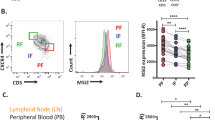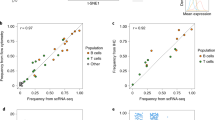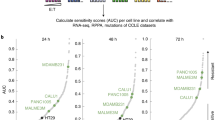Abstract
We have previously shown that ICAM-1-deficient mice were resistant to lymphoma dissemination of intravenously injected 164T2 lymphoma cells. Highly aggressive variants of this cell line, however, could overcome this resistance. To discern the complex pattern of gene expression involved in the evolution of aggressiveness in lymphoma cells, we compared the transcriptome of 164T2 cells with that of their aggressive variants using cDNA arrays. We identified several genes that were differentially expressed in nonmetastatic lymphoma cells and their metastatic variants. Galectin-7, associated with the development of chemically induced mammary carcinoma, was one such gene whose expression was significantly upregulated. We showed that it was constitutively expressed in aggressive variants, at both mRNA and protein levels. Galectin-7 expression in aggressive lymphoma cells was induced upon in vivo selection in several organs, including the thymus, the spleen and kidneys. We also showed that treatment of nonaggressive lymphoma cells with 5-aza-2′-deoxycytidine was sufficient to induce galectin-7 gene expression. This report is the first to show that galectin-7 is expressed in aggressive lymphoma.
This is a preview of subscription content, access via your institution
Access options
Subscribe to this journal
Receive 12 print issues and online access
$259.00 per year
only $21.58 per issue
Buy this article
- Purchase on Springer Link
- Instant access to full article PDF
Prices may be subject to local taxes which are calculated during checkout






Similar content being viewed by others
References
Poste G, Fidler IJ . The pathogenesis of cancer metastasis. Nature 1980; 283: 139–146.
Lockhart DJ, Winzeler EA . Genomics, gene expression and DNA arrays. Nature 2000; 405: 827–836.
Dustin ML, Rothlein R, Bhan AK, Dinarello CA, Springer TA . Induction by IL 1 and interferon-gamma: tissue distribution, biochemistry, and function of a natural adherence molecule (ICAM-1). J Immunol 1986; 137: 245–254.
Dustin ML, Springer TA . Role of lymphocyte adhesion receptors in transient interactions and cell locomotion. Annu Rev Immunol 1991; 9: 27–66.
Stroeken PJ, van Rijthoven EA, van der Valk MA, Roos E . Targeted disruption of the beta1 integrin gene in a lymphoma cell line greatly reduces metastatic capacity. Cancer Res 1998; 58: 1569–1577.
Aoudjit F, Potworowski EF, Springer TA, St-Pierre Y . Protection from lymphoma cell metastasis in ICAM-1 mutant mice: a posthoming event. J Immunol 1998; 161: 2333–2338.
Sligh JE, Ballantyne CM, Rich SS, Hawkins HK, Smith CW, Bradley A et al. Inflammatory and immune responses are impaired in mice deficient in intercellular adhesion molecule 1. Proc Natl Acad Sci USA 1993; 90: 8529–8533.
Xu H, Gonzalo JA, St Pierre Y, Williams IR, Kupper TS, Cotran RS et al. Leukocytosis and resistance to septic shock in intercellular adhesion molecule 1-deficient mice. J Exp Med 1994; 180: 95–109.
Dolcetti R, Maestro R, Gasparotto D, Rizzo S, Boiocchi M . Adhesion molecule expression does not influence the leukemic behavior of murine T-cell lymphomas. Leukemia 1992; 6(Suppl 3): 101S–105S.
Aoudjit F, Potworowski EF, St-Pierre Y . The metastatic characteristics of murine lymphoma cell lines in vivo are manifested after target organ invasion. Blood 1998; 91: 623–629.
Jonas P, Holzmann B, Jablonski-Westrich D, Hamann A . Dissemination capacity of murine lymphoma cells is not dependent on efficient homing. Int J Cancer 1998; 77: 402–407.
Aoudjit F, Potworowski EF, St-Pierre Y . Bi-directional induction of matrix metalloproteinase-9 and tissue inhibitor of matrix metalloproteinase-1 during T lymphoma/endothelial cell contact: implication of ICAM-1. J Immunol 1998; 160: 2967–2973.
Bogetto L, Gabriele E, Cariati R, Dolcetti R, Spessotto P, Doglioni C et al. Bidirectional induction of the cognate receptor-ligand alpha4/VCAM-1 pair defines a novel mechanism of tumor intravasation. Blood 2000; 95: 2397–2406.
Lalancette M, Aoudjit F, Potworowski EF, St-Pierre Y . Resistance of ICAM-1-deficient mice to metastasis overcome by increased aggressiveness of lymphoma cells. Blood 2000; 95: 314–319.
Stetler-Stevenson M, Mansoor A, Lim M, Fukushima P, Kehrl J, Marti G et al. Expression of matrix metalloproteinases and tissue inhibitors of metalloproteinases in reactive and neoplastic lymphoid cells. Blood 1997; 89: 1708–1715.
Kossakowska AE, Hinek A, Edwards DR, Lim MS, Zhang CL, Breitman DR et al. Proteolytic activity of human non-Hodgkin's lymphomas. Am J Pathol 1998; 152: 565–576.
Imamura J, Miyoshi I, Koeffler HP . p53 in hematologic malignancies. Blood 1994; 84: 2412–2421.
Pinyol M, Cobo F, Bea S, Jares P, Nayach I, Fernandez PL et al. p16(INK4a) gene inactivation by deletions, mutations, and hypermethylation is associated with transformed and aggressive variants of non-Hodgkin's lymphomas. Blood 1998; 91: 2977–2984.
Hernandez L, Fest T, Cazorla M, Teruya-Feldstein J, Bosch F, Peinado MA et al. p53 gene mutations and protein overexpression are associated with aggressive variants of mantle cell lymphomas. Blood 1996; 87: 3351–3359.
Madsen P, Rasmussen HH, Flint T, Gromov P, Kruse TA, Honore B et al. Cloning, expression, and chromosome mapping of human galectin-7. J Biol Chem 1995; 270: 5823–5829.
Magnaldo T, Bernerd F, Darmon M . Galectin-7, a human 14-kDa S-lectin, specifically expressed in keratinocytes and sensitive to retinoic acid. Dev Biol 1995; 168: 259–271.
Lu J, Pei H, Kaeck M, Thompson HJ . Gene expression changes associated with chemically induced rat mammary carcinogenesis. Mol Carcinog 1997; 20: 204–215.
Polyak K, Xia Y, Zweier JL, Kinzler KW, Vogelstein B . A model for p53-induced apoptosis. Nature 1997; 389: 300–305.
Bernerd F, Sarasin A, Magnaldo T . Galectin-7 overexpression is associated with the apoptotic process in UVB-induced sunburn keratinocytes. Proc Natl Acad Sci USA 1999; 96: 11329–11334.
Magnaldo T, Fowlis D, Darmon M . Galectin-7, a marker of all types of stratified epithelia. Differentiation 1998; 63: 159–168.
Masters JR, Lakhani SR . How diagnosis with microarrays can help cancer patients. Nature 2000; 404: 921.
Golub TR, Slonim DK, Tamayo P, Huard C, Gaasenbeek M, Mesirov JP et al. Molecular classification of cancer: class discovery and class prediction by gene expression monitoring. Science 1999; 286: 531–537.
Alizadeh AA, Eisen MB, Davis RE, Ma C, Lossos IS, Rosenwald A et al. Distinct types of diffuse large B-cell lymphoma identified by gene expression profiling. Nature 2000; 403: 503–511.
Wellmann A, Thieblemont C, Pittaluga S, Sakai A, Jaffe ES, Siebert P et al. Detection of differentially expressed genes in lymphomas using cDNA arrays: identification of clusterin as a new diagnostic marker for anaplastic large-cell lymphomas. Blood 2000; 96: 398–404.
Clark EA, Golub TR, Lander ES, Hynes RO . Genomic analysis of metastasis reveals an essential role for RhoC. Nature 2000; 406: 532–535.
Lossos IS, Alizadeh AA, Eisen MB, Chan WC, Brown PO, Botstein D et al. Ongoing immunoglobulin somatic mutation in germinal center B cell-like but not in activated B cell-like diffuse large cell lymphomas. Proc Natl Acad Sci USA 2000; 97: 10209–10213.
Feinberg AP, Vogelstein B . Hypomethylation distinguishes genes of some human cancers from their normal counterparts. Nature 1983; 301: 89–92.
Laird PW, Jaenisch R . The role of DNA methylation in cancer genetic and epigenetics. Annu Rev Genet 1996; 30: 441–464.
Baylin SB, Herman JG . DNA hypermethylation in tumorigenesis: epigenetics joins genetics. Trends Genet 2000; 16: 168–174.
Pogribny IP, Pogribna M, Christman JK, James SJ . Single-site methylation within the p53 promoter region reduces gene expression in a reporter gene construct: possible in vivo relevance during tumorigenesis. Cancer Res 2000; 60: 588–594.
Kudo S, Fukuda M . Tissue-specific transcriptional regulation of human leukosialin (CD43) gene is achieved by DNA methylation. J Biol Chem 1995; 270:13298–13302.
Feinberg AP, Vogelstein B . Hypomethylation distinguishes genes of some human cancers from their normal counterparts. Nature 1983; 301: 89–92.
Jackson-Grusby L, Beard C, Possemato R, Tudor M, Fambrough D, Csankovszki G et al. Loss of genomic methylation causes p53-dependent apoptosis and epigenetic deregulation. Nat Genet 2001; 27: 31–39.
Chen D, Rudland PS, Chen HL, Barraclough R . Differential reactivity of the rat S100A4(p9Ka) gene to sodium bisulfite is associated with differential levels of the S100A4 (p9Ka) mRNA in rat mammary epithelial cells. J Biol Chem 1999; 274: 2483–2491.
Hanada M, Delia D, Aiello A, Stadtmauer E, Reed JC . bcl-2 gene hypomethylation and high-level expression in B-cell chronic lymphocytic leukemia. Blood 1993; 82: 1820–1828.
MacDougall JR, Bani MR, Lin Y, Muschel RJ, Kerbel RS . ‘Proteolytic switching’: opposite patterns of regulation of gelatinase B and its inhibitor TIMP-1 during human melanoma progression and consequences of gelatinase B overexpression. Br J Cancer 1999; 80: 504–512.
Trainer DL, Kline T, Mallon F, Greig R, Poste G . Effect of 5-azacytidine on DNA methylation and the malignant properties of B16 melanoma cells. Cancer Res 1985; 45: 6124–6130.
Aoudjit F, Masure S, Opdenakker G, Potworowski EF, St-Pierre Y . Gelatinase B (MMP-9), but not its inhibitor (TIMP-1), dictates the growth rate of experimental thymic lymphoma. Int J Cancer 1999; 82: 743–747.
St-Pierre Y, Aoudjit F, Lalancette M, Potworowski EF . Dissemination of T cell lymphoma to target organs: a post-homing event implicating ICAM-1 and matrix metalloproteinases. Leukemia Lymphoma 1999; 34: 53–61.
Haier J, Nicolson GL . Tumor cell adhesion under hydrodynamic conditions of fluid flow. APMIS 2001; 109: 241–262.
Kuwabara I, Kuwabara Y, Yang RY, Schuler M, Green DR, Zuraw BL et al. Galectin-7 (PIG1) exhibits pro-apoptotic function through JNK activation and mitochondrial cytochrome c release. J Biol Chem 2002; 277: 3487–3497.
Perillo NL, Marcus ME, Baum LG . Galectins: a versatile modulators of cell adhesion, cell proliferation, and cell death. J Mol Med 1998; 76: 406–412.
Sanford GL, Harris-Hooker S . Stimulation of vascular cell proliferation by beta-galactoside specific lectins. FASEB J 1990; 4: 2912–2918.
Perillo NL, Pace KE, Seilhamer JJ, Baum LG . Apoptosis of T cells mediated by galectin-1. Nature 1995; 378: 736–739.
Inohara H, Raz A . Functional evidence that cell surface galectin-3 mediates homotypic cell adhesion. Cancer Res 1995; 55: 3267–3271.
Yang RY, Hsu DK, Liu FT . Expression of galectin-3 modulates T-cell growth and apoptosis. Proc Natl Acad Sci USA 1996; 93: 6737–6742.
Konstantinov KN, Robbins BA, Liu FT . Galectin-3, a beta-galactoside-binding animal lectin, is a marker of anaplastic large-cell lymphoma. Am J Pathol 1996; 148: 25–30.
Acknowledgements
This work was supported by a grant from the Canadian Institute for Health Research (YSP and EFP). YSP is a scholar of the Fonds de la Recherche en Santé du Québec (FRSQ). MD and JM are supported by studentships from La Fondation Armand-Frappier and the Fond pour la Formation de Chercheur et Aide à la Recherche (FCAR), respectively. We thank Ms Doris Legault and Claire Beauchemin for their excellent technical assistance. We fondly dedicate this paper to Claire Beauchemin, a key member of our research group for 25 years, who died on 14 May 2002.
Author information
Authors and Affiliations
Rights and permissions
About this article
Cite this article
Moisan, S., Demers, M., Mercier, J. et al. Upregulation of galectin-7 in murine lymphoma cells is associated with progression toward an aggressive phenotype. Leukemia 17, 751–759 (2003). https://doi.org/10.1038/sj.leu.2402870
Received:
Accepted:
Published:
Issue Date:
DOI: https://doi.org/10.1038/sj.leu.2402870
Keywords
This article is cited by
-
Imitating evolution’s tinkering by protein engineering reveals extension of human galectin-7 activity
Histochemistry and Cell Biology (2021)
-
Galectin-7 Regulates Keratinocyte Proliferation and Differentiation through JNK-miR-203-p63 Signaling
Journal of Investigative Dermatology (2016)
-
Galectin-1 as a potent target for cancer therapy: role in the tumor microenvironment
Cancer and Metastasis Reviews (2012)
-
Triggering of T-cell leukemia and dissemination of T-cell lymphoma in MMP-9-deficient mice
Leukemia (2007)



